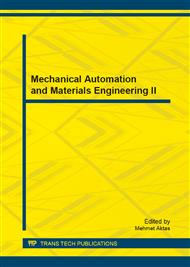p.277
p.282
p.286
p.291
p.296
p.303
p.308
p.312
p.317
Numerical Simulation of the Aerodynamic Performance of a H-Type Wind Turbine during Self-Starting
Abstract:
The aerodynamic performance and the bypass flow field of a vertical axis wind turbine under self-starting are investigated using CFD simulations in this paper. The influence of pitch angle variations on the performance of the wind turbine during self-starting is presented. A two-dimensional model of the wind turbine with three blades is employed. A commercial software FlowVision is employed in this paper, which uses dynamic Cartesian grid. The SST turbulence model is used for turbulence modeling, which assumes the flow full turbulent. Based on the comparison between the computed time-dependent variations of the rotation speed with the experimental data, the time-dependent variations of the torque are presented. The characteristics of self-starting of the wind turbine are analyzed with the pitch angle of 0o、-2o and 2o. The influence of pitch angle variations on two-dimensional unsteady viscous flow field through velocity contours is discussed in detail.
Info:
Periodical:
Pages:
296-302
Citation:
Online since:
June 2014
Keywords:
Price:
Сopyright:
© 2014 Trans Tech Publications Ltd. All Rights Reserved
Share:
Citation:


